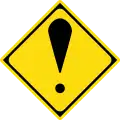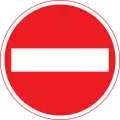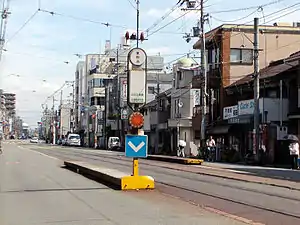Road signs in Japan
In Japan, road signs (道路標識, dōro-hyōshiki) are standardized by the "Order on Road Sign, Road Line, and Road Surface Marking (道路標識、区画線及び道路標示に関する命令)" established in 1968 with origins from the Tokyo Metropolitan Police Department's "Order on Standardization of Road Sign" of 1934 and the Home Ministry of Japan's "Order on Road Signs" of 1942.[1] The previous designs have been used since 1986 after several amendments of order.[2]



They are divided into "Principal Sign" (本標識, hon-hyōshiki) and "Supplemental Sign" (補助標識, hojo-hyōshiki).
Principal signs
Principal Signs (本標識, hon-hyōshiki) are categorized into 4 types; guide, warning, regulatory and instruction signs.
Guide signs
Guide signs (案内標識, an'nai-hyōshiki) indicates directions or distances of the road. Guide signs have dark green backgrounds and white text for expressways. In urban areas and on national highways, direction signs have dark blue backgrounds. The signs are normally written in Japanese and English. Since 2014 Vialog is used as the typeface for English words and Place name Transcriptions.
 Expressway ramp ahead
Expressway ramp ahead.svg.png.webp) Expressway exit ahead
Expressway exit ahead.svg.png.webp) Exits and distance (expressway)
Exits and distance (expressway) Junction (expressway)
Junction (expressway).png.webp) Expressway number (E1; Tomei)
Expressway number (E1; Tomei).svg.png.webp) Expressway shield (E4; Tōhoku)
Expressway shield (E4; Tōhoku)
 Intersection
Intersection Intersection
Intersection Distance of cities and areas
Distance of cities and areas National highway shield (Route 20)
National highway shield (Route 20) National highway shield
National highway shield National highway shield
National highway shield Prefectural highway shield (Fukuoka Route 758)
Prefectural highway shield (Fukuoka Route 758) Prefectural highway shield
Prefectural highway shield Prefectural highway shield (inter-city route)
Prefectural highway shield (inter-city route) Prefectural highway shield
Prefectural highway shield Prefectural highway shield (inter-city route)
Prefectural highway shield (inter-city route) Street name
Street name Detour
Detour Detour
Detour Mitigated limitation of height (expressway)
Mitigated limitation of height (expressway) Mitigated limitation of weight
Mitigated limitation of weight
Warning signs
Warning signs (警戒標識, keikai-hyōshiki) warn drivers of dangers or situations that they must pay attention to. Their design, black pattern and border on yellow diamond (usually with 45 cm per a side), is based on the U.S. MUTCD.[4]
 Crossroads
Crossroads Traffic Circle
Traffic Circle Succession of more than two curves to the right
Succession of more than two curves to the right Railroad crossing ahead (old)
Railroad crossing ahead (old) Railroad crossing ahead
Railroad crossing ahead School area
School area Traffic lights ahead
Traffic lights ahead Slippery surface
Slippery surface Falling rocks
Falling rocks Bumpy road
Bumpy road Traffic merges from the left
Traffic merges from the left Left lane ends
Left lane ends Road narrows on both sides
Road narrows on both sides Two-way traffic ahead
Two-way traffic ahead Steep descent (10%)
Steep descent (10%) Steep ascent (10%)
Steep ascent (10%) Roadworks
Roadworks Dangerous wind gusts
Dangerous wind gusts Wild animals crossing (deer)
Wild animals crossing (deer) Other dangers
Other dangers
Regulatory signs
Regulatory signs (規制標識, kisei-hyōshiki) show the regulations of each roads in order to keep road condition and prevent dangers of traffic.
The stop sign is a red, downward-pointing triangle, with the text 止まれ (tomare) & "stop" (in English, for the pre-1963 and current designs only) in white. Prohibition signs are round with white backgrounds, red borders, and blue pictograms. Mandatory instruction signs are round with blue backgrounds and white pictograms.
- Stop and slow down
 Slow down (In Japanese and English, current design from 2017)
Slow down (In Japanese and English, current design from 2017) Slow down (In Japanese Only, phased out in 2017)
Slow down (In Japanese Only, phased out in 2017) Yield (abolished in 2017)
Yield (abolished in 2017) Stop (In Japanese and English, current design from 2017)
Stop (In Japanese and English, current design from 2017) Stop (In Japanese Only, used from 1963 to 2017)
Stop (In Japanese Only, used from 1963 to 2017).svg.png.webp) Stop sign, used from 1950 to 1960
Stop sign, used from 1950 to 1960.svg.png.webp) Stop sign, used from 1960 to 1963
Stop sign, used from 1960 to 1963
- Exclusions
 Road closed to all
Road closed to all Road closed to vehicles
Road closed to vehicles No entry
No entry No motor vehicles except motorcycles and mopeds
No motor vehicles except motorcycles and mopeds No trucks
No trucks No buses
No buses No motorcycles or mopeds
No motorcycles or mopeds No nonmotorized vehicle
No nonmotorized vehicle No bicycles
No bicycles No motor vehicles
No motor vehicles No two-person motorcycles
No two-person motorcycles No vehicles carrying dangerous goods
No vehicles carrying dangerous goods No vehicles weighing over 5.5 tonnes
No vehicles weighing over 5.5 tonnes No vehicles higher than 3.3 metres
No vehicles higher than 3.3 metres No vehicles wider than 2.2 metres
No vehicles wider than 2.2 metres Motor vehicles only
Motor vehicles only Bicycles only
Bicycles only Pedestrians only
Pedestrians only Road closed to pedestrians
Road closed to pedestrians
- Turns
 Straight ahead or left turn permitted
Straight ahead or left turn permitted Straight ahead or right turn permitted
Straight ahead or right turn permitted Turn left
Turn left Turn right
Turn right No turns
No turns Turn left or right
Turn left or right Directions permitted
Directions permitted Roundabout
Roundabout Keep left
Keep left Keep right
Keep right No right turn crossing ahead
No right turn crossing ahead No U-turn
No U-turn Two-stage right turn for mopeds
Two-stage right turn for mopeds No two-stage right turn for mopeds
No two-stage right turn for mopeds
- Restrictions
 No crossing centre line when overtaking
No crossing centre line when overtaking.svg.png.webp) Speed limit (90 km/h)
Speed limit (90 km/h)_and_507-C.svg.png.webp) End of speed restriction limit
End of speed restriction limit_and_507-A.svg.png.webp) End of speed restriction limit[5]
End of speed restriction limit[5].svg.png.webp) Minimum speed limit (50 km/h)
Minimum speed limit (50 km/h) One-way street to the left
One-way street to the left One way street to the right
One way street to the right One-way street ahead
One-way street ahead One way (bicycle)
One way (bicycle).svg.png.webp) Trucks use left lane[6]
Trucks use left lane[6].svg.png.webp) Buses-only lane
Buses-only lane Bicycle lane
Bicycle lane.svg.png.webp) Buses-priority lane
Buses-priority lane.svg.png.webp) Lane usage
Lane usage.svg.png.webp) Lane usage
Lane usage.svg.png.webp) Lane usage
Lane usage.svg.png.webp) Lane usage
Lane usage Use car horns
Use car horns No pedestrian crossing
No pedestrian crossing
- Parking and Stopping
 No stopping
No stopping No parking
No parking Restricted parking
Restricted parking Parallel parking
Parallel parking Right-angle parking
Right-angle parking Slanting parking
Slanting parking
Instruction Signs
Instruction signs (指示標識, shiji-hyōshiki) show points and devices on the road that drivers should pay attention.
 Stop line
Stop line Centre line
Centre line Driving on tram rail permitted
Driving on tram rail permitted
.svg.png.webp) Parking permissive
Parking permissive Stopping permissive
Stopping permissive Pedestrian crossing
Pedestrian crossing School crossing
School crossing Bicycle crossing
Bicycle crossing Bicycle and pedestrian crossing
Bicycle and pedestrian crossing Controls ahead
Controls ahead
Supplemental signs
Supplemental signs (補助標識, hojo-hyōshiki) are usually put just below the principal signs, and shows their valid range like time, day and category of vehicle.[7] They are equivalent to the "plaque" of the American MUTCD. The width of the plates is usually 60 cm, and the sentences should be less than 7 characters per a line or 3 lines.[8] When the sentences can not be shortened less than the limitation, they should apply changeable signs.[8]
 100 meters ahead
100 meters ahead Next 50 meters
Next 50 meters Except Sundays and Holidays
Except Sundays and Holidays 8 a.m. to 8 p.m.
8 a.m. to 8 p.m. Except mopeds
Except mopeds Bicycles (symbol)
Bicycles (symbol) Large vehicles carrying over 3 tonnes (symbol)
Large vehicles carrying over 3 tonnes (symbol) Restriction begins
Restriction begins Restriction begins (symbol)
Restriction begins (symbol) Restricted zone
Restricted zone Restricted zone (symbol)
Restricted zone (symbol) End of restriction
End of restriction End of restriction (symbol)
End of restriction (symbol) End of restriction
End of restriction
Other signs
 Expressway name (Tomei)
Expressway name (Tomei) Asian Highway route shield (AH1)
Asian Highway route shield (AH1) Ferry (pictogram established in Japanese Industrial Standards)
Ferry (pictogram established in Japanese Industrial Standards)
"Stop" sign changes

In 2016, it was announced that the Japanese National Police Agency was considering changing the design of the "Stop" sign used on Japanese roads since 1963 from the inverted red triangle sign to an octagonal design more closely conforming to the recommendations of the 1968 Vienna Convention on Road Signs and Signals.[9] The inverted red triangle sign was introduced in 1963 ahead of the 1964 Tokyo Olympic Games, and replaced the earlier red octagonal sign used from 1960, which in turn had replaced the yellow octagonal sign used from 1950.[9] It was later decided to make the stop sign bilingual in both Japanese and English, but to maintain the inverted triangular shape.[10]
Photographs
 Street name and highway shields (Chiba Prefecture)
Street name and highway shields (Chiba Prefecture) Expressway ramp ahead (with expressway number)
Expressway ramp ahead (with expressway number) Intersection
Intersection.jpg.webp) Mitigated limitations of weight and height
Mitigated limitations of weight and height Lane usage
Lane usage Lane usage (changeable)
Lane usage (changeable) Directions permitted
Directions permitted Tram stop
Tram stop Crossing prohibition (7-9 a.m.) ends
Crossing prohibition (7-9 a.m.) ends Taxis without passenger can not enter at 9 p.m.-2 a.m.
Taxis without passenger can not enter at 9 p.m.-2 a.m. Restrictions 200 m ahead
Restrictions 200 m ahead Asian highway sign and symbol of Nihonbashi (Shuto Expressway)
Asian highway sign and symbol of Nihonbashi (Shuto Expressway)
References
| Wikimedia Commons has media related to Road signs in Japan. |
- 時崎賢二 1990, p. 22.
- dark-RX 2008, p. 105.
- "Fuenfwerken-Schrift in Japan | Fuenfwerken". www.fuenfwerken.com (in German). Retrieved 2018-03-23.
- 時崎賢二 1979, p. 24.
- A left arrow or ここまで in the supplemental sign (plaque) means "END". A right arrow or ここから in the plaque means "BEGIN".
- The symbol can be changed to other vehicles.
- 全標協 2013, p. 3(設置)
- 警察庁 2017, p. 32.
- "Design of Japanese stop signs might change ahead of Olympic tourism surge". The Japan Times. Japan: The Japan Times Ltd. 21 January 2016. Retrieved 23 January 2016.
- "英語併記の新標識お目見え 一時停止に「STOP」". 日本経済新聞 電子版 (in Japanese). Retrieved 2018-01-24.
Bibliography
- 時崎賢二 (1979). "道路標識等の基礎知識". 月刊交通. 東京法令出版. 10 (5): 18–29.
- 時崎賢二 (1990). "道路標識の国際化". 月刊交通. 東京法令出版. 21 (4): 19–39.
- dark-RX (2008-03-20). "見つけよう! 旧標識". 酷道をゆく. イカロス出版: 104–107. ISBN 978-4-86320-025-8.
- 全国道路標識標示業協会(編) (2013). 道路標識ハンドブック (2012年度版 ed.). 全国道路標識・標示業協会.
- 警察庁交通局 (2017-04-24). "交通規制基準" (PDF). 警察庁. Retrieved 2017-11-08.
- "道路標識、区画線及び道路標示に関する命令 別表第2". www.mlit.go.jp. Retrieved 2018-01-24.
- "17062814_ichiran(止まれ、徐行正式版追加)" (PDF). www.mlit.go.jp (PDF). 2017-06-28. Retrieved 2018-01-25.